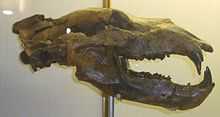Ursus etruscus
| Ursus etruscus Temporal range: Pliocene–Pleistocene | |
|---|---|
 | |
| Fossils | |
| Scientific classification | |
| Kingdom: | Animalia |
| Phylum: | Chordata |
| Class: | Mammalia |
| Order: | Carnivora |
| Suborder: | Caniformia |
| Superfamily: | Arctoidea |
| Family: | Ursidae |
| Subfamily: | Ursinae |
| Tribe: | Ursini |
| Genus: | Ursus |
Ursus etruscus (Etruscan bear) is an extinct species of mammal of the family Ursidae (bears), endemic to Europe, Asia and North Africa during the Pliocene through Pleistocene, living from ~5.3 Mya—11,000 years ago, existing for approximately 5.289 million years.
Ursus etruscus appears to have come from Ursus minimus and gave rise to the brown bear, Ursus arctos, and the cave bear, Ursus spelaeus. The range of Ursus etruscus is mostly continental Europe with specimens also recovered in the Great steppe region of Eurasia. The latest fossil evidence for Ursus etruscus was recovered in Israel, Croatia, and Toscana, Italy dating at 1.8 Mya to 11,000 years.
Some scientists have proposed that the early, small variety of U. etruscus of the middle Villafranchian era survives in the form of the modern Asian black bear.[1]
Morphology

Not unlike the brown bears of Europe in size, it had a full complement of premolars, a trait carried from the genus Ursavus.
Fossil distribution
Sites and specimen ages:
- Vassiloudi, Macedonia Greece ~5.3—1.8 Ma.
- Obigarm, Tajikistan ~5.3—1.8 Ma.
- Ahl al Oughlam, Morocco ~3.6—1.8 Ma.
- Pardines, Auvergne, France ~2.5—1.8 Ma.
- Dmanisi, Georgia ~1.8 Ma.—800,000 years ago.
- Mestas de Con, Cangas de Onis, Asturias, Spain ~1.8—100,000 years ago.[2]
- Strmica, Croatia ~1.8—11,000 years ago.[3]
References
- ↑ Aspects of Evolution and Adaptation in American Black Bears (Ursus americanus Pallas) and Brown and Grizzly Bears (U. arctos Linne.) of North America, Stephen Herrero, Research Associate, Environmental Sciences Centre (Kananaskis), and Assistant Professor, Department of Biology and Psychology, University of Calgary, Alberta.
- ↑ Paleobiology Database: Mestas de Con, Cangas de Onis collection
- ↑ Paleobiology Database: Strmica collection
- Catherine Hanni, Vincent Laudet, Dominique Stehelin, and Pierre Taberleto (1994). Tracking the origins of the cave bear (Ursus spelaeus) by mitochondrial DNA sequencing. Proc. Natl. Acad. Sci. USA, Vol. 91, pp. 12336-12340.